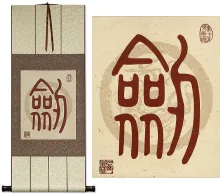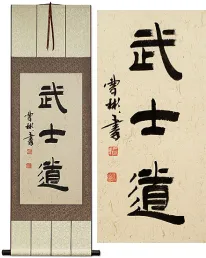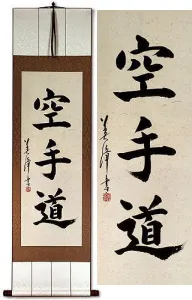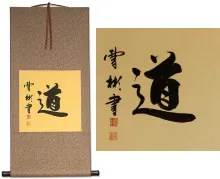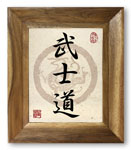Many custom options...
And formats...

The Way of the Sword in Chinese / Japanese...
Buy a The Way of the Sword calligraphy wall scroll here!
Kendo / The Way of the Sword
Often associated with Kenjutsu, 剱道/劍道 means “The way of the sword” in Japanese (and Korean with an alternate form of the first character).
This is also the term used for swordsmanship and even fencing in Japanese and Korean, depending on context.
Note: These same characters are also used separately in Chinese, but this exact combination yields a common title in Japanese only (perhaps someone who is really into swords would use this in China).
Note: There is more than one way to write the “sword” character (shown above is the Japanese version - if you want the Korean version, please let me know when you place your order).
This in-stock artwork might be what you are looking for, and ships right away...
Gallery Price: $106.00
Your Price: $58.88
Gallery Price: $200.00
Your Price: $98.88
Gallery Price: $108.00
Your Price: $59.88
Gallery Price: $200.00
Your Price: $118.88
Gallery Price: $268.00
Your Price: $148.77
Gallery Price: $87.00
Your Price: $47.88
Gallery Price: $200.00
Your Price: $118.88
Gallery Price: $200.00
Your Price: $118.88
Gallery Price: $200.00
Your Price: $118.88
Not the results for the way of the sword that you were looking for?
Below are some entries from our dictionary that may match your the way of the sword search...
| Characters If shown, 2nd row is Simp. Chinese |
Pronunciation Romanization |
Simple Dictionary Definition |
殺法 see styles |
sappou / sappo さっぽう |
way of murdering; killing method; way of using a sword |
剣の道 see styles |
kennomichi けんのみち |
(exp,n) (See 道・みち・8) way of the sword; swordsmanship |
打把勢 打把势 see styles |
dǎ bǎ shi da3 ba3 shi5 ta pa shih |
drill (in sword play); to thrash around; to demonstrate gymnastic skills; to solicit financial help (in an indirect way); to show off |
巴陵三轉語 巴陵三转语 see styles |
bā líng sān zhuǎn yǔ ba1 ling2 san1 zhuan3 yu3 pa ling san chuan yü Haryō san tengo |
The three cryptic sayings of Hàojiàn 顥鑑 styled Baling, name of his place in Yuèzhōu 嶽州. He was the successor of Yunmen 雲門. 'What is the way ? The seeing fall into wells. What is the feather-cutting sword (of Truth)? Coral branches (i. e. moonbeams) prop up the moon. What is the divine (or deva) throng ? A silver bowl full of snow. ' |
The following table may be helpful for those studying Chinese or Japanese...
| Title | Characters | Romaji (Romanized Japanese) | Various forms of Romanized Chinese | |
| Kendo The Way of the Sword | 剱道 / 劍道 剣道 | kendou / kendo | jiàn dào / jian4 dao4 / jian dao / jiandao | chien tao / chientao |
| In some entries above you will see that characters have different versions above and below a line. In these cases, the characters above the line are Traditional Chinese, while the ones below are Simplified Chinese. | ||||
Successful Chinese Character and Japanese Kanji calligraphy searches within the last few hours...

